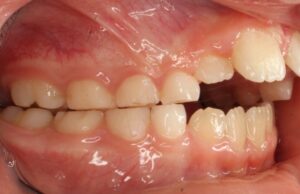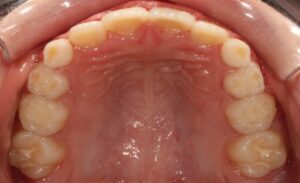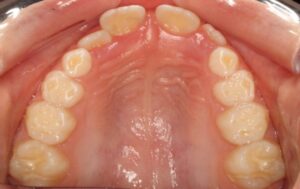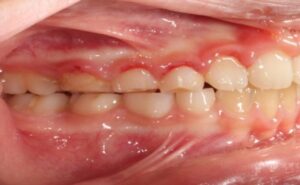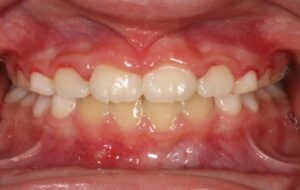Tongue Thrust
What is a tongue thrust?
A tongue thrust occurs during swallowing. The tongue should normally move forward and upward compressing against the roof of the mouth to create a seal so swallowing can occur. Instead, it moves forward between the upper and lower front teeth. The pressure every time a swallow occurs exacerbates a front teeth open bite and will often deform the shape of the upper jaw from U-shaped to more V-shaped.
(Pretreatment with front teeth open bite)
So, a tongue thrust is functional in that the patient can swallow fine but, it is detrimental to the shape of the upper jaw, the bite and tooth alignment.
Why does a tongue thrust develop?
In many instances, tongue thrusting is the response to a front teeth open bite which was there to begin with. In other words, the patient develops the tongue thrust to compensate for the front teeth open bite. So it is very important in these patients to correct the open bite so the tongue can develop a normal swallowing pattern.
A limited number of people have a tongue thrust without a front teeth open bite. If so, unless there is an associated speech issue then there is no reason to treat. The speech issues are with the “th” and “s” sounds. Have the patient say “there, that, sixty six and sixty seven.” The words will sound slightly slurred, if so, refer to a Speech Therapist.
There are many causative factors for tongue thrusting such as:
- Hereditary
- Thumb or finger sucking
- Enlarged tonsils or adenoids
- Allergies/nasal congestion
- Tongue tied
- Macroglossia (large tongue)
-Heredity and thumb or finger sucking are similar since both result in “V” shaped upper arch which makes it impossible for the tongue to fit in the correct position. A specifically designed upper expander with thumb/finger guard works great.
-Enlarged tonsils or adenoids cause the tongue to position forward. This occurs because the upper airway in constricted due to the size of the tonsils so the tongue will have to move forward to open the airway for breathing. Large adenoids make it harder to breathe through the nose so the patient will position the tongue low and forward for airway. The same is true for allergies/nasal congestion. A upper expander with tongue trainer along with removal of the tonsils/adenoids or allergy treatment is the treatment of choice.
-With a tongue tied patient, the lack of tongue mobility makes it impossible for the tongue to move to the correct position. A upper expander with a removal of the frenum is the correct treatment.
-With marcoglossia the size of the tongue prohibits correct positioning. You can’t reduce the size of tongue very often so have to expand the upper jaw as much as possible to accommodate the tongue.
(After treatment with our specially designed upper expander with tongue guard of patient in initial photos)
Now you understand tongue thrust. Let us know if we can be of help!



